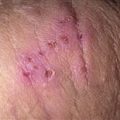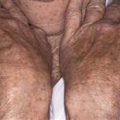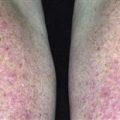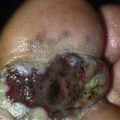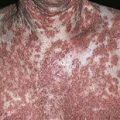Subacute eczematous
inflammation
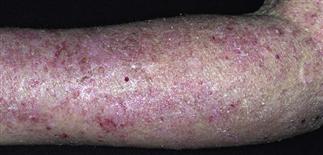
Arm with subacute eczematous changes, which include confluent erythema and secondary changes of scaling, erosions, and crusts. Atopic dermatitis or allergic contact dermatitis appears this way.

Nipple eczema is a finding in atopic dermatitis. Subacute eczematous changes seen here are scaling, erythema, fissuring, and crusting. The skin appears dry.
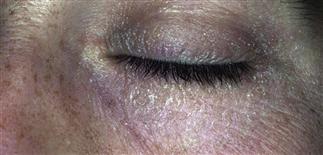
Eczema around the eye area. The patient was allergic to a component of her moisturizer. Fragrance materials and preservatives in make-up and toiletries can be acquired allergies at any time in life.
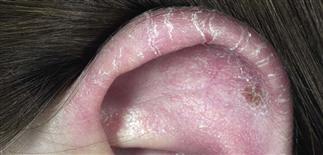
Ear with xerosis, erythema, and crusting typical of subacute eczematous inflammation.
DESCRIPTION
Subacute eczematous inflammation consists of itchy, red, and scaling patches, papules, and plaques.
HISTORY
• May evolve from acute (vesicular) eczema. • Most common clinical manifestation of atopic dermatitis. • Itching variable; can be moderate to severe, or rather mild. • Resolves without scarring when provoking or contributing aggravating factors are removed. May require treatment to resolve. • Excoriation and repeated exposure to aggravating conditions (water, detergents, irritants, or other common irritant or allergic offenders) convert this condition to a chronic process. • Nummular eczema, fingertip eczema, scabies, and fungal infections are dermatoses that may present as subacute eczema. • Attention to exposures of irritants, allergens, and patient’s overall skin care regimen is vital to addressing cause and aggravating factors.
PHYSICAL FINDINGS
• Erythema, scaling, and itching occur; often, there are indistinct borders. • Patchy redness may be faint or intense.
TREATMENT
• Moisturizers are an essential part of daily therapy; encourage frequent application. • Moisturizers are most effective when rubbed in well and applied directly after skin is patted dry following bathing. • Emollients with simple formulations lacking the most common allergy-associated ingredients (e.g. Aveeno, Cetaphil, DML, Acid Mantle) are better than lotions. Plain petroleum jelly is an excellent emollient. • Infrequent washing with bar-type mild soap (e.g. Dove, Cetaphil, Keri, Purpose, Basis) is also helpful. • Group II–V steroid creams twice a day with or without plastic occlusion. Occlusion hastens resolution while increasing absorption. Duration of occlusion should be specified, limited, and supervised. • Alternative is steroid ointment applied twice a day without occlusion. • Non-steroid topical immune modulators tacrolimus (Protopic ointment 0.1, 0.03%) and pimecrolimus (Elidel cream 1%) applied twice daily to affected skin are especially useful in subacute eczema of the face or periorbital eyelid skin. May initially cause some stinging or burning, which subsides in a few days. These therapies are useful for chronic management of subacute eczema in atopic patients. • Tar ointments and creams (many over-the-counter preparations) provide an alternative to steroid-resistant lesions and are moderately effective. • Wet dressings should be avoided, because they cause excessive dryness. • Antibiotics (e.g. trimethoprim-sulfa, cephalexin, dicloxacillin) for secondary bacterial infections (usually Staphylococcus aureus, but sensitivity should be checked). • Ask about occupation, duties at home, and hobbies, as these may contribute to ongoing skin irritation or allergy. Gloves are a useful protective barrier in cases of repeated exposure to water, irritants, or allergens. Vinyl gloves are best, because they do not contain common rubber-related allergens (gloves can be ordered online from http://www.allerderm.com). Allerderm Ultimate N-Dex Free Nitrile exam gloves do are non-latex, powder free, accelerator and antioxidant free gloves with excellent chemical resistance properties.

